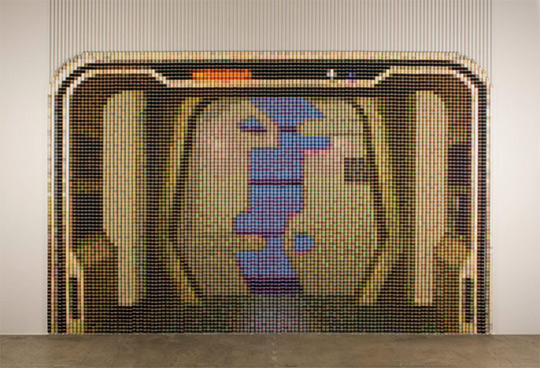Holodeck:
Simulation Program..., 2007-08
by Devorah Sperber


Detail view
The thread spool installation titled: Holodeck: Simulation Program..., 2008 is a rendition of the interior view of the Holodeck doorway and arch (TNG). This perspective places the viewer inside the holodeck (vs. outside looking in). Thus, the gallery and everything and everyone in it, as well as the city seen through the gallery windows, can be thought of as part the holodeck's virtual-simulation program. The title of this work will change with each exhibition, to reflect the time and location of each simulated Holodeck program.
Holodeck: Simulation Program… expresses my ongoing interest in presenting "reality" as a subjective experience vs. an absolute "truth" more literally than any work I have created to date. It supports the idea that "reality" is an illusion created by the human brain through unconscious processes by which raw perceptual data is input, filtered, and organized to create a holographic illusion of a solid, predictable universe.
About Holodecks: (from Wikipedia) A holodeck is a simulated reality facility located on starships and starbases in the fictional Star Trek universe. A holodeck is an enclosed room in which objects and people are simulated by a combination of replicated matter, tractor beams, and shaped force fields onto which holographic images are projected. Sounds and smells are simulated by speakers and fragranced fluid atomizers, respectively. The feel of a large environment is simulated by suspending the participants on force fields which move with their feet, keeping them from reaching the walls of the room (a virtual treadmill). Perspective is retained through use of sound damping fields and graviton lenses, which make objects, people, and sounds appear to be more distant. The effect is an ultra-realistic simulation of an environment, with which the user can interact. User controls for a holodeck are typically located near its door (inside and out); on the inside an arch surrounds the exit and can be revealed by a user to start, modify, or stop a simulation (as seen in the thread spool installation Holodeck: Simulation Program...).
Premise: Holodeck Simulation Program... debuted in my exhibition titled "Mirror Universe" which exemplified my continued interest in the links between art and science-- in particular how consciousness and the act of seeing create the illusion of a stable, predictable, and singular universe.
The title "Mirror Universe" was inspired by the 1967 Star Trek episode Mirror, Mirror in which a transporter mishap switches the crew of the Enterprise with their evil counterparts, trapping them in a "savage parallel universe." This struck a poignant chord.
Although I am not a "Trekkie," I have a vague recollection of watching reruns of the original Star Trek series in the 1970s with my father. I also watched Star Trek: The Next Generation (a.k.a. TNG) for a while in late 1980s, but I was never a fanatic until 2002, when for a few months, I began scheduling my days so I could watch reruns of Star Trek: TNG shown every afternoon on Spike TV. I remember wondering why I was so intrigued.
Eventually I realized that series Star Trek: TNG offered an escape from the tumultuous post 9-11 world by presenting a utopian perspective of humanity at its best. The mission of the TNG Enterprise was exploration and with the exception of the Borg (their defining motto was "resistance is futile"), the crew's confrontations with alien life-forms were mostly based on misunderstandings and cultural differences vs. battles between good and evil. The idea of doing a series based on Star Trek has been gestating since that time. The concept and title for this exhibition gelled when I realized every Star Trek series had at least one episode based on the concept of a mirror or parallel universe, which fit in with my ongoing interest in the link between art and science, human perception, and subjective reality.
About Parallel Universes: "For years Parallel Universes have been a staple of science fiction. Scientists now believe there may really be a parallel universe - in fact, there may be an infinite number of parallel universes, and we just happen to live in one of them. It started when superstring theory, hyperspace and dark matter made physicists realize that the three dimensions we thought described the Universe weren't enough. By the time they had finished they'd come to the conclusion that there are eleven dimensions and that our Universe is just one bubble among an infinite number of membranous bubbles which ripple as they wobble through the eleventh dimension."- Quoted from the BBC Television Program: Parallel Universes (February, 14, 2002)
*Partial funding by Coats and Clark
Devorah Sperber is a New York-based artist whose sculptures, composed of thousands of ordinary objects, negotiate a terrain between low and high tech. Her labor-intensive works explore repetition and the effects of digital technology on perception, scale, and subjective reality. -Patricia Phillips, Executive Editor, Art Journal
© Devorah Sperber Inc. 2000